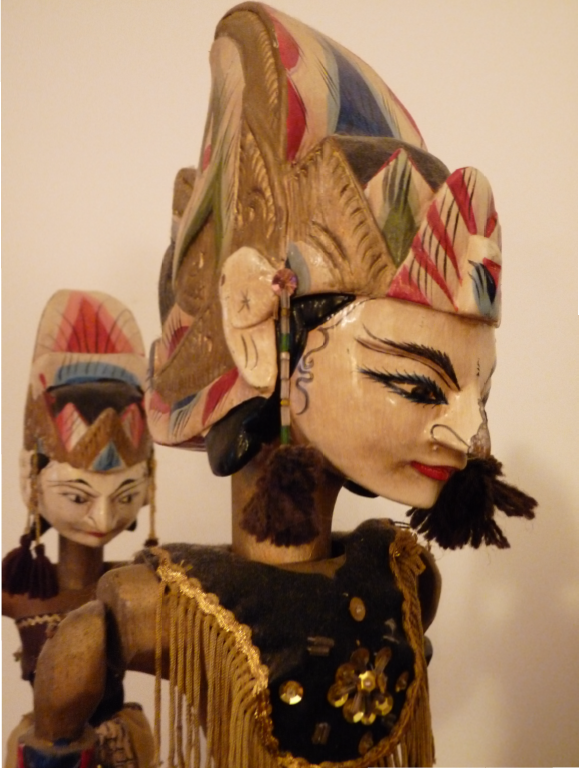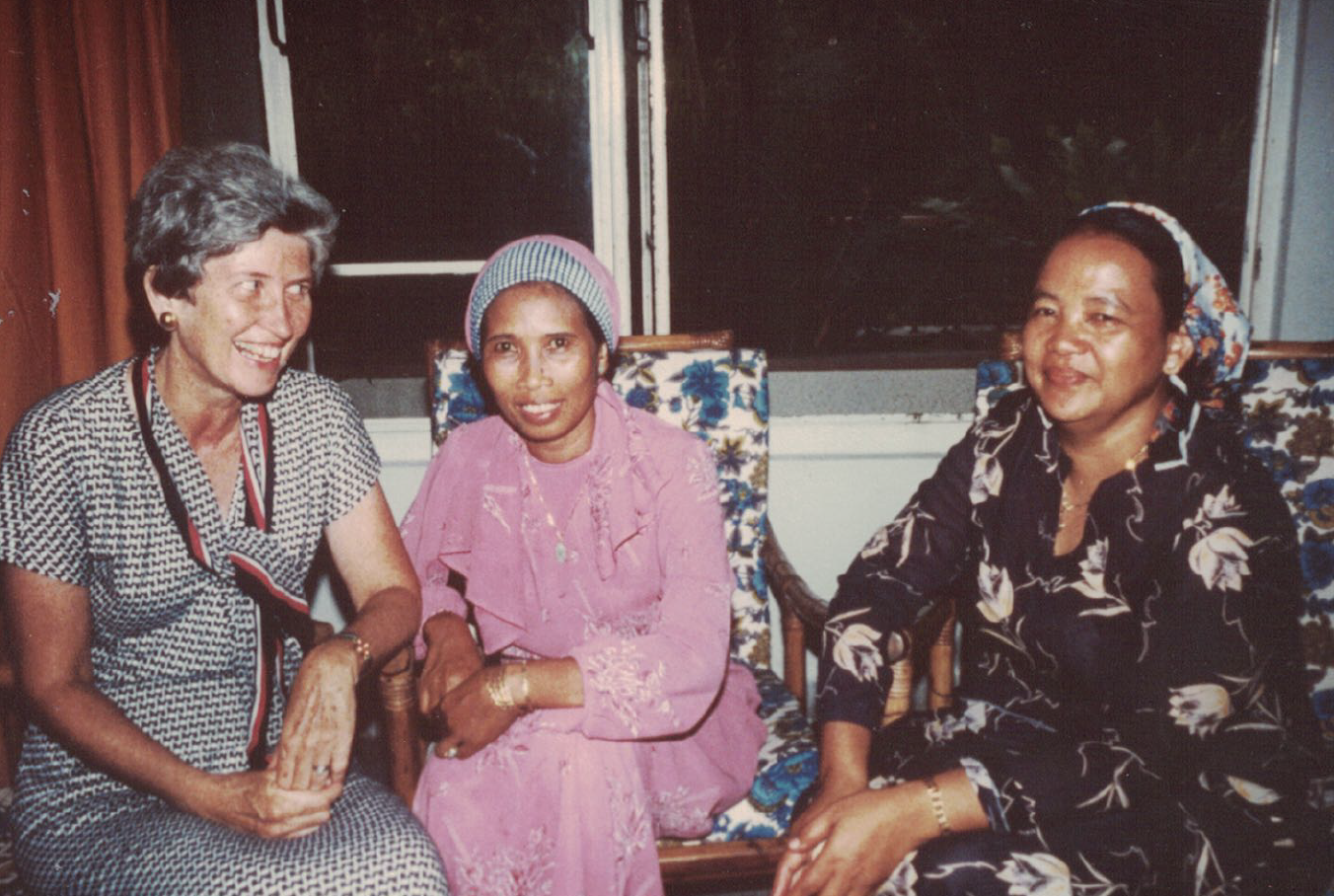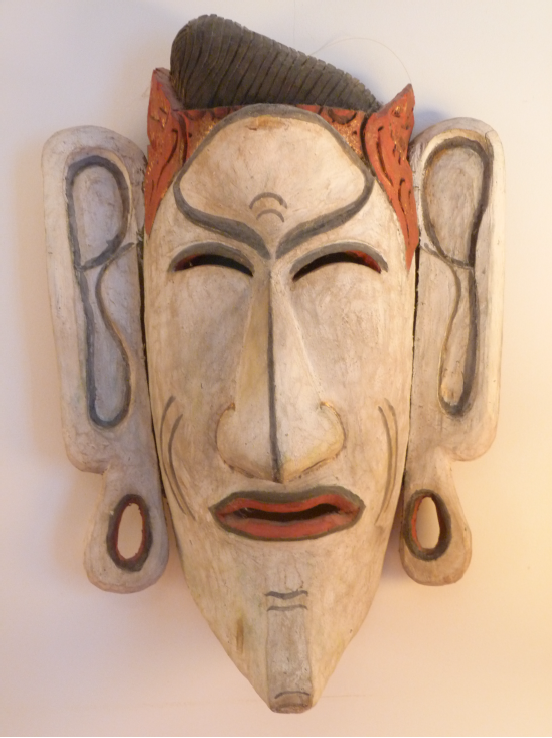The Nelsons and Collecting
The most striking thing about the Nelson collection is not its size or diversity or the quality of the objects, though it is large and diverse and made up of odd and beautiful things. A collection catalogue is a very good tool for examining objects individually and by class, but rather a blunt one for exploring the intimate relationships that develop among people and things when they share the same space over the course of decades.
Upon entering the Nelsons’ gracious Southern home near the University of Virginia, the visitor was immediately struck both by how unexpected it was to be instantly surrounded by so many objects from such distant places and by how harmoniously they were combined. Dayak short swords and Sumatran blowpipes hung cheek by jowl with Iban ritual masks and horns for containing magical powders. The effect was dynamic instead of jarring. It is a difficult effect to achieve and reflects an uncommon constancy of taste and vision. So, though this catalogue presents the objects in the Nelson collection, it should be borne in mind that the most extraordinary thing about it is the way in which the Nelsons lived with it, surrounding themselves with exotic objects that became the essential features of their domestic landscape.
Collection and display of curiosities and souvenirs are ancient practices with vast literatures. The earliest extant tourist guidebook, Pausanias’s Description of Greece (which also included tips on visiting Turkey and Egypt) was written around 160 AD for well-to-do Roman citizens on two-year grand tours of the Mediterranean, and included advice on the best souvenirs and vendors. The standard gifts that Chinese visitors were expected to bring home from Vietnam were established well within the first millennium. While leaving one’s own mark on famous places visited was popular as well (Romans in particular liked to carve their names on even more antique monuments), bringing home a token of faraway places has been a habit of travelers from and to everywhere for a very long time, and for many a central part of the experience is to gather objects that, from their perspective, both embody the destination and bring a fundamentally foreign element into familiar spaces; a sort of trophy of experience.

The draw of the truly foreign was the seed of the wonder-cabinets of the sixteenth and seventeenth century, which drew on the wealth and taste for the exotic gained from European trade with Asia and the Renaissance spirit of inquiry to assemble collections of fabulous objects meant to represent the breadth of human and natural possibility. These wunder-kammern, the forebears of the museum, started as the collections of adventurous individuals and families like the Tradescants, who assembled on the South Bank of London a wonder-cabinet called the Ark, which was later to form the core of the collection of Oxford’s Ashmolean, the first university museum. Gardeners to Charles I, they traveled widely, collecting exotic plants and everything else that struck them as noteworthy—the skins of odd animals, tools and weapons from across the known world, anatomical curiosities, and a ceremonial robe belonging to Chief Powhatan of Virginia. The Ark was filled floor to ceiling with wonders, as were most museums until the early twentieth century, and arranged according to themes (such as “Ways of Dealing with Dead Enemies” and “Horns Grown by Human-Women”) rather than by period or place of origin. The purpose of the collections and the style of display was to overwhelm the viewer with the richness of creation rather than to provide context or information on individual things, which were often mis- or poorly-understood by the curators themselves. Objects were selected with an eye to the bizarre, the hyper-exotic, and the contrary to accepted rules of nature.
In this sense, the culture of display was in contrast to the later emerging culture of collecting, which prized the representative. These representative collecting practices did not converge in most museums until the twentieth century, when connoisseurship and changes in ethnographic practices and representation led to an emphasis on the fully contextualized display of paragon objects—those that were meant to represent the purest or highest expression of a given type.
The sort of collecting and display in which the Nelsons engaged both descends from and is fundamentally different from both the casualness of souvenir collecting and the exoticism or relentless connoisseurship of museum display. Throughout their travels and beyond, Sally chose objects very deliberately, and indeed the collection as a whole is united above all by her distinctive taste for the colorful and dramatic. This is doubtless one of the reasons the objects she gathered are not the broadly representative specimens favored by most collectors unfamiliar with Southeast Asian art and culture—even the shadow puppets, which are a very popular souvenir of Indonesia and Malaysia, are mainly either uncommon characters or represented in an unusual way.

While this poses some challenges in evaluating them, more importantly it illuminates the quality that unites collecting and display, but which has never really been satisfactorily treated in studies of material culture—personal aesthetic sense. Taste as a marker of status—that is, the objects, foods, décor and so forth that are broadly considered to be in good taste by a given socio economic class—has been the subject of much scholarly speculation since the first major work on it was published in 1979. But aside from its role as an element of cultural hegemony, taste is a difficult thing to discuss meaningfully in an anthropological context.
We can certainly observe common themes that unite the Nelsons’ collection: a very powerful, almost stark graphic sense, a preference for dark and earthy colors with highlights of brightness, a somewhat sinister presentation of the human face in particular, a trend towards elongated forms. It is, however, impossible to draw out any broad inferences from them, partly because they are so contrary to what one would normally expect to be the tastes of Americans of the Nelsons’ age and background.
And this is the charm of the collections of interesting people. Where obsessiveness and connoisseurship are absent, idiosyncrasy and personal experience take their places, and the results are unpredictable and exciting. The Nelsons’ collection is a record of both their travels and the experiences that gave them such a particular eye for unique and compelling objects.
Nelson South East Asia Collection © 2025


